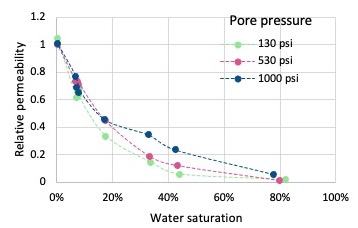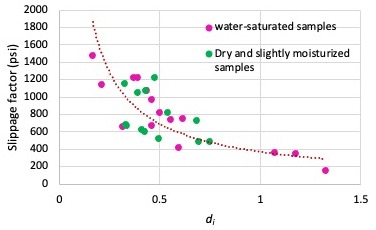Gas flow and the Klinkenberg effect in nanoporous rocks


Gas flow in nanoporous rocks is a central theme in discussions of gas production from shales, coal seams, and other unconventional reservoirs; it is also a key component of caprock evaluation in CO₂ subsurface sequestration. In contrast to liquid flow, the non-continuum effect becomes dominant in gas flow with decreasing pore diameter (d) that is comparable to a mean free path (λ) at low pressure because of gas-pore surface collision. Various flow regimes can be divided on the basis of the Knudsen number (Kn=λ/d)—i.e., viscous flow (Kn<0.001), slip flow (0.001<Kn<0.1), transition flow (0.1<Kn<10), and free-molecular or Knudsen flow (Kn>10). In some research, the boundary Kn value between slip and viscous flows is 0.01. Because pore diameters in nanoporous rocks range from nano- to micrometer, gas flow in this type of rock can span three flow regimes (viscous, slip, and transition flow) or even all four regimes under laboratory (150–1,000 psi) and general reservoir (1,000–5,000 psi or higher) conditions. In comparison with conventional reservoir rocks, in which microscale or larger pores limit flow in only viscous and slip-flow regimes, a wider span of flow regimes in nanoporous rocks is the biggest difference, causing more complexity in gas flow and permeability characterization. We then found that the linear Klinkenberg correction, currently a common practice even for shale, is not appropriate for intrinsic (or liquid) permeability determination in shale or tight formation rocks.
Water saturation (S𝑤) is another important influencing factor on gas flow and the Klinkenberg effect, although it is relatively less studied. On the basis of gas permeability under different saturations, we found that the Klinkenberg effect decreases with increasing water saturation because of the preferential filling of water in smaller pores in shale. Gas relative permeability and gas diffusivity at different water saturations are higher at higher pore pressure in general.
Representative publications
Peng, S., Advanced understanding of gas flow and the Klinkenberg effect in nanoporous rocks. Journal of Petroleum Science and Engineering, https://doi.org/10.1016/j.petrol.2021.109047
Peng, S., B. Ren, M. Meng, 2019. Quantifying the Influence of Fractures for More Accurate Laboratory Measurement of Shale Matrix Permeability using a Modified Gas Expansion Method, SPE Reservoir Evaluation & Engineering-Formation Evaluation, SPE-195570-PA, doi:/10.2118/195570-PA.
Peng, S., B. Loucks, 2016. Permeability measurements in Mudrocks using gas-expansion methods on plug and crushed-rock samples. Marine and Petroleum Geology, doi:10.1016/j.marpetgeo.2016.02.025.